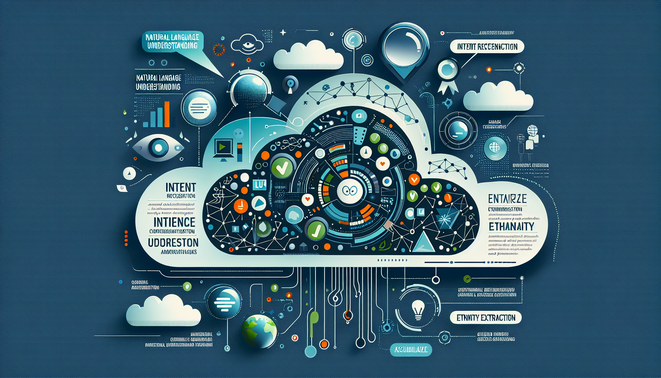Physical Address
304 North Cardinal St.
Dorchester Center, MA 02124
Physical Address
304 North Cardinal St.
Dorchester Center, MA 02124

Understanding Natural Language Understanding (NLU) in Cloud Services
Meta Summary: Discover the crucial role of Natural Language Understanding (NLU) in enhancing AI-driven user experiences through cloud services. This article delves into the components, applications, and future trends of NLU, while providing insights and best practices for successful implementation.
Introduction to Natural Language Understanding (NLU)
Natural Language Understanding (NLU) is a cornerstone in artificial intelligence, enabling computers to comprehend human language as naturally spoken or written. This ability is increasingly vital as technology integrates into our daily lives, enhancing user experiences through intuitive human-machine interactions.
Learning Objectives
Define Natural Language Understanding (NLU) and its importance in AI.
Recognize the role of NLU in enhancing user experiences.
NLU focuses on interpreting user input to bridge the communication gap between humans and machines. By doing so, it enables applications to interpret queries, extract relevant details, and generate natural, meaningful responses.
Differences Between NLU and NLP
Understanding the distinction between Natural Language Processing (NLP) and Natural Language Understanding (NLU) is essential for harnessing their full potential in language processing technologies.
Learning Objectives
Distinguish between Natural Language Processing (NLP) and NLU.
Identify scenarios where NLU is preferred over NLP.
NLP encompasses a wide range of tasks, including language translation, speech recognition, and text summarization. In contrast, NLU zeros in on understanding the semantics and intent behind the text, making it ideal for customer service chatbots that need to accurately interpret user intentions.
Core Components of NLU
NLU systems rely on several critical components that work together to interpret and understand human language.
Learning Objectives
List and describe essential components of NLU like intent recognition and entity extraction.
Explain how these components interact within NLU systems.
Intent Recognition
Intent recognition is crucial for determining a user’s desired action based on their input. For example, when a user types “Book a flight to New York,” this component identifies “book a flight” as the intended action.
Entity Extraction
Entity extraction identifies and classifies critical pieces of information in a text. In the previous example, it recognizes “flight” as the service and “New York” as the destination, forming the backbone of understanding in NLU systems.
Applications of NLU in Cloud Services
NLU’s scalability and efficiency make it ideal for cloud-based services, significantly enhancing business operations and user satisfaction.
Learning Objectives
Explore practical use cases of NLU in chatbots and automated customer support.
Discuss the impact of NLU on business efficiency and customer satisfaction.
Practical Use Cases
NLU enhances chatbots and customer support systems by understanding customer queries more effectively. A leading e-commerce platform, for instance, integrated NLU into its chatbot, achieving a 30% reduction in response time.
Business Impact
Incorporating NLU into cloud services boosts efficiency by automating routine queries, allowing human agents to address more complex issues. The improved accuracy and responsiveness of NLU-powered systems enhance user satisfaction.
Implementing NLU: Tools and Techniques
Effectively integrating NLU into cloud applications requires the right tools and best practices.
Learning Objectives
Identify popular tools for NLU implementation in cloud applications.
Outline step-by-step procedures for integrating NLU into existing systems.
Popular Tools
Top NLU tools include Google Dialogflow, IBM Watson, and Microsoft Azure’s language services, offering robust frameworks for developing NLU applications with pre-built models and customizable features.
Integration Steps
Define User Scenarios: Identify the scenarios and intents your NLU system will manage.
Select a Tool: Choose an NLU tool that fits your needs and infrastructure.
Train the Model: Use sample data to focus on intent recognition and entity extraction.
Integrate with Applications: Connect the NLU system via APIs for seamless data flow.
Test and Refine: Conduct extensive testing and refine the model based on feedback.
Exercises
Create a simple chatbot using an NLU tool like Dialogflow or IBM Watson.
Set up an NLU service on a cloud provider and integrate it with a test application.
Best Practices
Continuously refine your NLU model with user feedback.
Extensively test NLU capabilities with real-world data.
Maintain clear documentation of intents and entities.
Pitfalls
Failing to update the NLU model periodically.
Underestimating user language variation complexity.
Choosing a tool that doesn’t align with specific NLU needs.
Future Trends in NLU
The evolving technology landscape promises exciting developments in NLU, revolutionizing cloud applications.
Learning Objectives
Discuss upcoming trends and technologies in NLU.
Predict the future landscape of NLU within cloud applications.
Emerging Technologies
Advancements in machine learning and deep learning will enable more sophisticated language understanding. Further, NLU integration with AI technologies like computer vision will enhance immersive user experiences.
Future Landscape
The future of NLU in cloud applications is bright, with potential expansions into real-time language translation, sentiment analysis, and predictive text generation. These advancements will further refine business processes and customer interactions.
Visual Aids Suggestions
Flowchart illustrating the NLU process from user input to response generation.
Key Takeaways
NLU is essential for enabling machines to understand human language.
NLU focuses on intent recognition and entity extraction, distinguishing it from broader NLP tasks.
Applications of NLU in cloud services significantly enhance business efficiency and customer satisfaction.
Implementing NLU requires selecting the right tools and following best practices.
The future of NLU is promising, with emerging trends offering sophisticated language understanding capabilities.
Glossary
Natural Language Understanding (NLU): The ability of a computer program to understand human language as it is spoken or written.
Natural Language Processing (NLP): A subfield of AI focused on the interaction between computers and humans through natural language.
Intent Recognition: The process of determining a user’s goal through their input.
Entity Extraction: The task of identifying and classifying essential information in text.
Knowledge Check
What is the primary function of Natural Language Understanding?
A) To translate languages
B) To understand human language
C) To recognize speech
D) To summarize text
Explain how intent recognition works in NLU.
Further Reading
IBM Cloud: Natural Language Understanding
Google Cloud: Natural Language Overview
Microsoft Azure: Cognitive Services Language Service